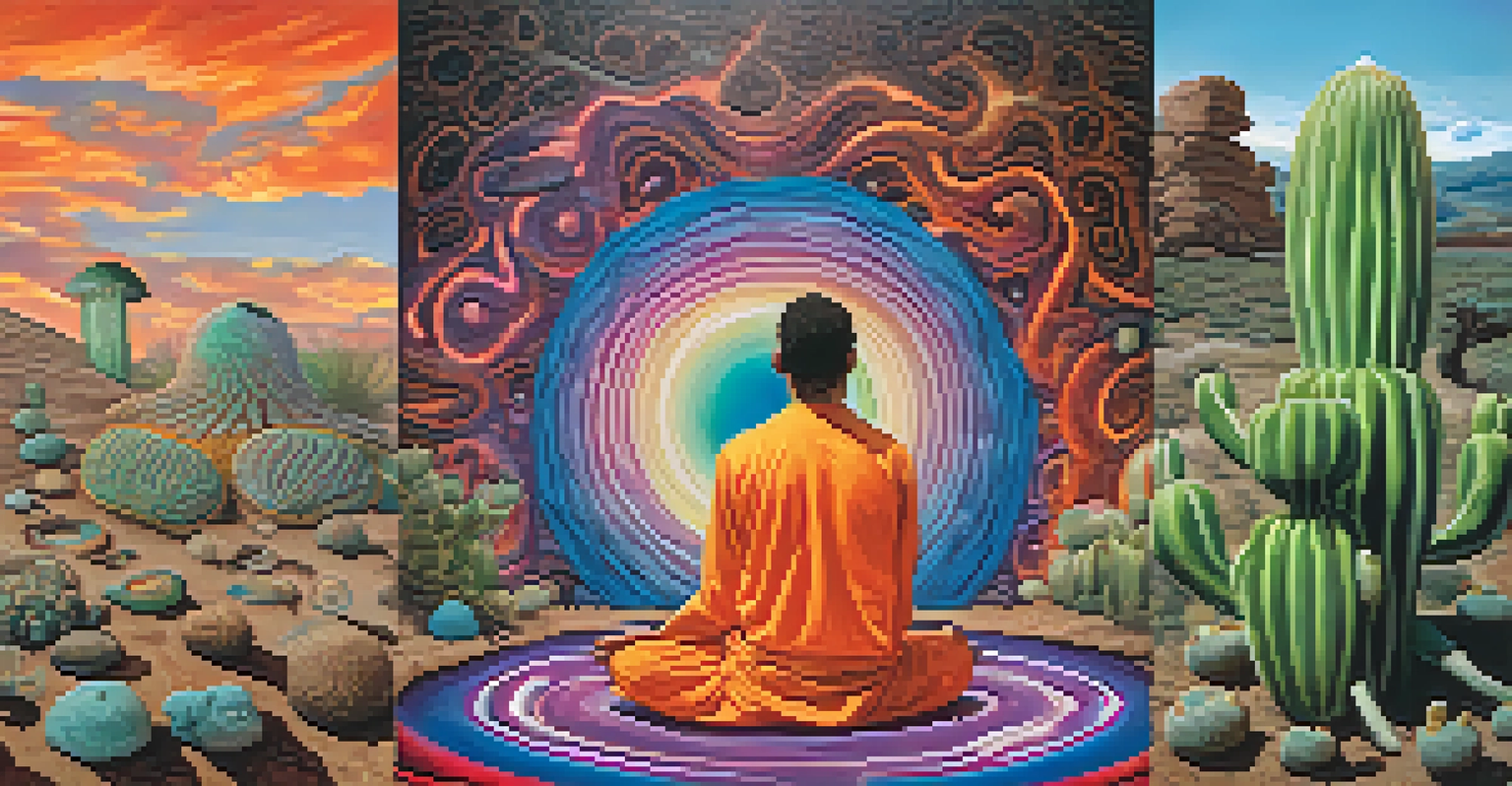Spiritual Uses: Peyote's Role vs. Psilocybin in Rituals

Understanding Peyote: A Sacred Cactus
Peyote, a small cactus native to North America, has been used for thousands of years in various spiritual and religious practices, particularly among Indigenous peoples. Its psychoactive compound, mescaline, induces vivid visions and deep introspection, making it a powerful tool for spiritual exploration.
The cactus is not only a tool for healing but also a bridge between the spiritual and the material worlds.
During rituals, Peyote is often consumed in a ceremonial setting, fostering a sense of community and connection among participants. This communal aspect is significant, as it helps individuals share their experiences and insights, reinforcing their spiritual bonds.
Related Resource
The use of Peyote is deeply rooted in traditions, such as the Native American Church, which emphasizes healing, guidance, and personal transformation. For many, these ceremonies provide a pathway to understanding oneself and the universe, highlighting the cactus's long-standing role in spiritual practices.
The Power of Psilocybin Mushrooms in Rituals
Psilocybin mushrooms, often referred to as magic mushrooms, contain psychoactive compounds that can lead to profound spiritual experiences. Used in various cultural contexts, these mushrooms are known for their ability to alter perception and evoke feelings of interconnectedness.

Rituals involving Psilocybin often focus on personal revelation and self-discovery. Participants may engage in guided sessions or group settings, where the shared experience can enhance the overall impact of the journey, allowing for deeper emotional connections.
Peyote's Spiritual Role
Peyote serves as a sacred plant in Indigenous cultures, fostering community and personal transformation through ceremonial use.
Recent research has highlighted the potential therapeutic benefits of Psilocybin, further legitimizing its use in spiritual contexts. As more people explore these mushrooms, their role in rituals may evolve, blending traditional practices with modern insights into mental health and well-being.
Comparing Spiritual Experiences: Peyote vs. Psilocybin
While both Peyote and Psilocybin offer unique spiritual experiences, their effects can differ significantly. Peyote tends to promote a sense of groundedness and connection to nature, while Psilocybin often heightens sensory perception and can lead to more abstract thought processes.
Psychedelics can provide a glimpse into the depths of the human experience, revealing the interconnectedness of all things.
Participants in Peyote rituals often report feelings of unity with the earth and a strong connection to their heritage. In contrast, those who engage with Psilocybin may experience a more individualistic journey, exploring personal insights and revelations that can sometimes be disorienting.
Related Resource
Ultimately, the choice between Peyote and Psilocybin may depend on individual preferences and the goals of the ritual. Understanding these differences can help participants select the most suitable substance for their spiritual journey.
Cultural Significance of Peyote in Indigenous Practices
Peyote holds immense cultural significance for many Indigenous groups, particularly in North America. For these communities, the cactus is more than just a psychoactive substance; it is a sacred plant that embodies their history, spirituality, and connection to the land.
Ceremonies involving Peyote often include songs, prayers, and rituals that have been passed down through generations. These practices foster a sense of identity and continuity, allowing participants to connect with their ancestors and cultural heritage.
Psilocybin's Modern Appeal
Psilocybin mushrooms are gaining popularity in contemporary spirituality for their potential in self-exploration and personal growth.
The preservation of these rituals is crucial, especially as external pressures threaten Indigenous ways of life. By maintaining their traditions around Peyote, these communities ensure that their spiritual practices remain vibrant and relevant for future generations.
The Role of Psilocybin in Modern Spirituality
In recent years, Psilocybin has gained traction in modern spiritual practices, particularly among those seeking alternative forms of healing and self-exploration. Many people are drawn to its potential for fostering personal growth and enhancing mindfulness.
Unlike Peyote, which is deeply rooted in Indigenous traditions, Psilocybin is often embraced by a more diverse group of practitioners, including those from secular backgrounds. This accessibility allows for a broader interpretation of spiritual experiences and encourages experimentation with various practices.
Related Resource
As interest in Psilocybin continues to grow, it is essential to approach its use with respect and intention. By understanding its historical and cultural contexts, individuals can create meaningful rituals that honor the essence of the mushrooms while navigating their own spiritual journeys.
Legal and Ethical Considerations in Spiritual Use
The legal status of both Peyote and Psilocybin varies significantly across different regions, impacting how they can be used in spiritual contexts. While Peyote is legally protected for Indigenous use in the U.S., Psilocybin is still illegal in many places, although some areas are beginning to decriminalize it.
Ethically, it is crucial for individuals to consider the cultural significance of these substances before incorporating them into their practices. Engaging with Indigenous traditions requires a respectful understanding of their histories and the implications of appropriation.
Respecting Cultural Contexts
Engaging with Peyote and Psilocybin requires understanding their cultural significance to ensure respectful and meaningful practices.
As more people explore the spiritual uses of these substances, fostering an open dialogue about legality and ethics becomes essential. This conversation can help ensure that practices remain respectful and meaningful for those involved, regardless of their backgrounds.
Finding Balance: Integrating Peyote and Psilocybin
For those interested in spiritual exploration, integrating both Peyote and Psilocybin into their practices can offer diverse experiences. Each substance provides unique insights and perspectives, allowing individuals to deepen their understanding of themselves and their place in the world.
Creating a balanced approach may involve participating in rituals that incorporate both substances or alternating between them based on personal needs and goals. This flexibility can enhance spiritual growth and foster a greater appreciation for the complexity of these experiences.

Ultimately, the journey of spiritual exploration is deeply personal. By embracing the distinct qualities of Peyote and Psilocybin, individuals can cultivate a richer tapestry of understanding that honors both their personal beliefs and the traditions from which these substances arise.